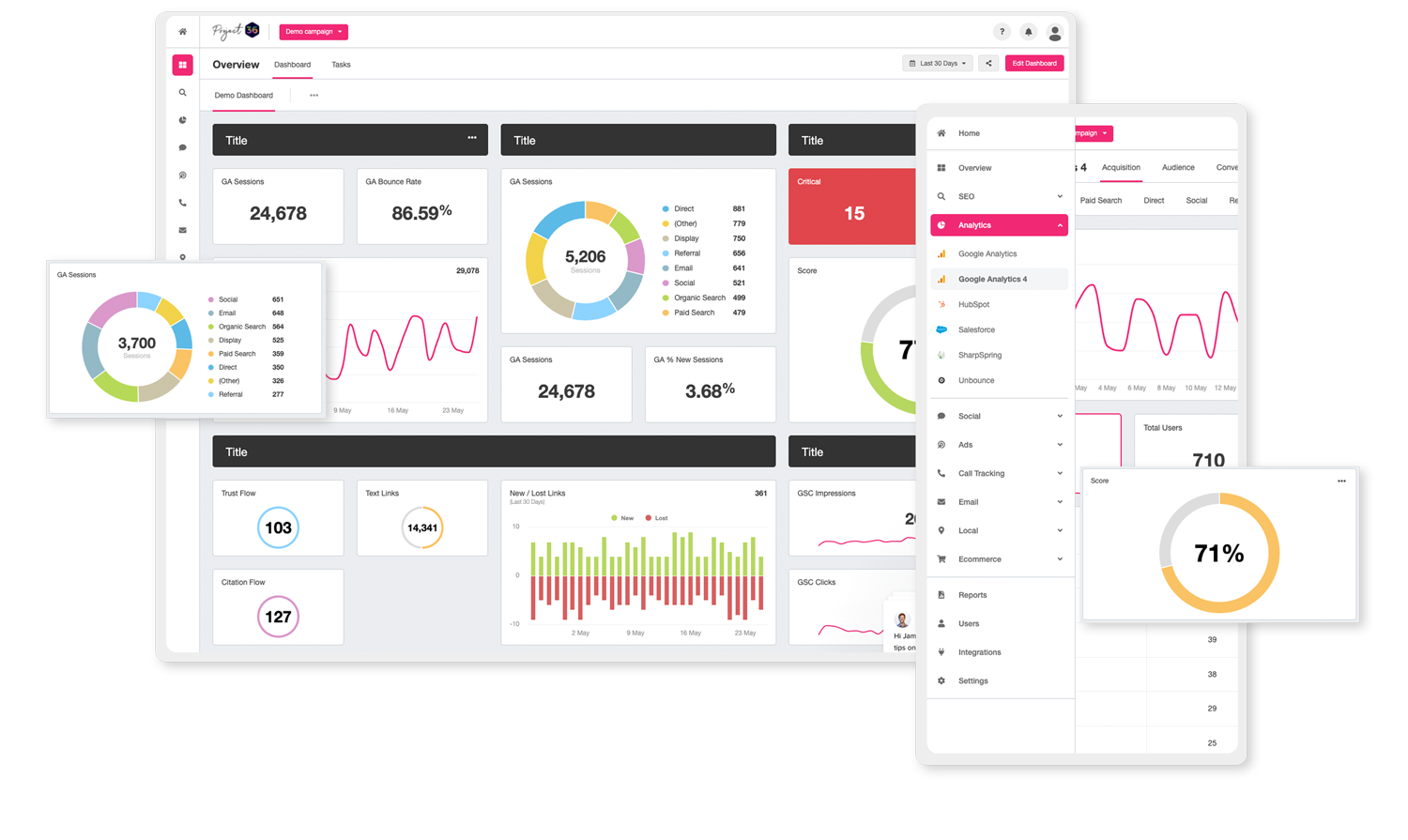The Ultimate Guide to Business Process Automation (BPA) in 2024
- Introduction: Business Process Automation (BPA)
- Part 1: Lead generation & nurturing
- Part 2: Personalisation & customer segmentation
- Part 3: Customer relationship management (CRM) integration
- Part 4: Streamlining sales processes
- Part 5: Reporting & analytics
- Part 6: Improved customer experience
- Part 7: Scalability
- Part 8: Conclusion
Business Process Automation (BPA)
Business Process Automation (BPA) plays a pivotal role in marketing and sales for technology and Software as a Service (SaaS) businesses. By automating repetitive tasks, streamlining processes, and optimising resources, BPA enables companies to enhance their efficiency and productivity, ultimately driving growth and revenue generation.
- Lead generation and nurturing: BPA can help automate the process of identifying potential customers, capturing their information, and nurturing them through the sales funnel. By using automated tools for social media posting, email marketing, and content creation, businesses can reach a wider audience and establish a consistent communication strategy with leads.
- Personalisation and customer segmentation: By analysing customer data, BPA allows marketers to create tailored content and offers for specific target groups. This level of personalisation can significantly improve customer engagement and conversion rates, ultimately boosting sales.
- Customer relationship management (CRM) integration: BPA facilitates seamless integration between marketing, sales, and CRM systems. This integration allows for improved collaboration and data sharing, ensuring all team members have access to relevant information about customers and leads, ultimately fostering more effective sales strategies.
- Streamlining sales processes: Automating routine sales tasks, such as generating quotes, sending follow-up emails, and updating records, can save valuable time and resources. Sales representatives can then focus on building relationships with prospects, closing deals, and upselling existing clients.
- Reporting and analytics: BPA tools can automatically collect, analyse, and report on marketing and sales data, providing valuable insights into campaign performance, customer behaviour, and sales trends. These insights enable companies to make data-driven decisions and refine their strategies to maximise return on investment (ROI).
- Improved customer experience: By automating customer support through chatbots, FAQs, and knowledge bases, businesses can provide quick, efficient responses to customer queries. This not only improves customer satisfaction but also frees up resources for other essential tasks.
- Scalability: BPA allows technology and SaaS businesses to scale their marketing and sales efforts more efficiently. By automating various tasks, they can handle larger volumes of leads and customers without the need for significant additional resources.

What Is Business Process Automation?
Lead generation and nurturing
Lead generation and nurturing are vital for tech and SaaS companies to attract potential customers and foster relationships that guide them through the sales funnel. By employing strategies such as content marketing, social media, SEO, and paid advertising, businesses can generate leads, capture their interest, and collect contact information. Nurturing these leads with personalised communication, multi-channel engagement, and timely follow-ups helps build trust, credibility, and rapport, ultimately converting prospects into loyal customers and driving business growth.
These processes involve attracting potential customers, fostering relationships with them, and guiding them through the sales funnel to convert them into loyal, paying clients. Here's an expanded look at these processes and how they apply to tech and SaaS businesses:
Lead Generation:The initial phase of lead generation involves identifying and attracting potential customers through various strategies, such as:
- Content marketing: Creating valuable, informative content like blog posts, ebooks, webinars, and whitepapers showcases a company's expertise and addresses the needs of its target audience, thus drawing their interest.
- Social media marketing: Utilising platforms like LinkedIn, Twitter, and Facebook allows businesses to engage with prospects, share relevant content, and participate in industry discussions, positioning their brand as a thought leader.
- Search engine optimisation (SEO): By optimising websites and content for search engines, companies can improve their online visibility, attract organic traffic, and target relevant keywords that resonate with potential clients.
- Paid advertising: Tech and SaaS companies can use pay-per-click (PPC) advertising, sponsored social media posts, and display ads to reach a larger audience and capture high-intent leads.
Lead Nurturing:
Once leads are generated, it's crucial to nurture them effectively and build relationships that guide them through the sales funnel. Key nurturing strategies include:
- Personalisation: Customising communication and content based on each prospect's preferences, behaviour, and needs increases engagement and the likelihood of conversion.
- Multi-channel communication: Engaging leads through various channels, such as email, social media, and phone calls, maintains a consistent dialogue and caters to their preferred communication methods.
- Timely follow-ups: Prompt and regular communication is essential in moving leads through the sales funnel. A well-timed follow-up can make a significant difference in converting a lead into a customer.
- Tracking and measurement: Utilising analytics tools to monitor lead nurturing efforts and assess their effectiveness enables businesses to identify areas for improvement and adapt their strategies for better results.
In summary, lead generation and nurturing are pivotal for tech and SaaS companies to attract potential customers, foster relationships, and guide prospects through sales.
By implementing effective strategies and continuously refining their approach, businesses can convert leads into loyal customers, thereby driving growth and long-term success.

Unlocking Success: Lead Generation and Nurturing for Tech and SaaS Businesses
Personalisation and customer segmentation
Personalisation and customer segmentation enable tech and SaaS companies to tailor their marketing and sales efforts to individual customer needs and preferences.
By dividing their customer base into distinct groups based on shared characteristics, such as demographics or purchasing behaviour, businesses can create targeted content, offers, and communication strategies that resonate with each segment.
This approach improves customer engagement, increases conversion rates, and enhances loyalty, ultimately driving growth and success for tech and SaaS businesses.
Personalisation and customer segmentation are essential strategies for tech and SaaS companies to cater to their diverse customer base and drive business growth. By understanding and addressing individual customer needs and preferences, these companies can create more targeted and impactful marketing campaigns. Here's an expanded overview of these strategies and their applications for tech and SaaS businesses:
Customer Segmentation:
Customer segmentation involves dividing the customer base into distinct groups based on shared characteristics, such as demographics, geographic location, purchasing behaviour, or product usage.
This process enables businesses to:
- Identify and focus on high-value customer segments
- Tailor marketing and sales efforts to each group's unique needs
- Allocate resources more effectively
- Track performance and measure success at the segment level
Personalisation:
With customer segmentation in place, tech and SaaS businesses can implement personalisation strategies to create targeted and relevant experiences for each customer group.
Some personalisation tactics include:
- Tailored content: Develop content that addresses the specific needs and interests of each customer segment, such as blog posts, case studies, and whitepapers.
- Email marketing: Craft targeted email campaigns with personalised subject lines, content, and offers that resonate with each customer segment.
- Product recommendations: Use customer data to suggest relevant products or services based on each individual's browsing and purchase history.
- Website personalisation: Customise website experiences by displaying tailored content, offers, and product recommendations based on the visitor's customer segment.
- Retargeting campaigns: Implement personalised retargeting ads with tailored messages and offers for customers who have previously interacted with the brand.
The benefits of combining personalisation and customer segmentation for tech and SaaS companies include:
- Enhanced customer engagement by providing relevant and valuable experiences
- Increased conversion rates and customer lifetime value
- Improved customer loyalty and retention
- Informed decision-making regarding marketing spend and resource allocation
In conclusion, personalisation and customer segmentation are powerful strategies that can help tech and SaaS businesses stand out in a competitive market. By understanding their customers' unique needs and preferences, they can create targeted marketing campaigns that drive engagement, increase conversions, and foster long-term loyalty. Continuously refining their approach and staying responsive to customers' evolving needs will ensure ongoing success.

The Power of Personalisation: Leveraging Customer Segmentation for Tech and SaaS Businesses
Customer relationship management (CRM) integration
CRM integration is a valuable tool for tech and SaaS companies, enabling them to connect their CRM systems with marketing, sales, and support platforms.
This centralises customer data, streamlines processes, and enhances team collaboration, resulting in improved efficiency and data-driven decision-making. By leveraging integrated CRM systems, businesses can create personalised customer experiences, boost engagement, and increase conversions, ultimately driving growth and success in the competitive tech and SaaS landscape.
CRM integration plays a crucial role in the growth and success of tech and SaaS companies by unifying customer data, streamlining operations, and fostering collaboration. By connecting CRM systems with marketing, sales, and support tools, businesses can enjoy a range of benefits that enhance their overall performance:
-
Centralised customer data: CRM integration consolidates customer data from multiple sources, providing a single, comprehensive view of each customer. This allows teams to easily access and share relevant information, ensuring consistency and accuracy across departments.
-
Improved collaboration: By integrating CRM systems with other business tools, communication between marketing, sales, and support teams is enhanced. This seamless collaboration ensures a consistent customer experience throughout the sales funnel, increasing the chances of conversion and fostering long-term loyalty.
-
Enhanced efficiency: CRM integration automates data synchronization and minimises manual data entry, saving time and reducing the risk of errors. This allows teams to focus on high-value tasks, such as nurturing leads and closing deals.
-
Data-driven decision-making: Integrated CRM systems offer valuable insights and analytics, enabling businesses to make informed decisions based on real-time data. This data-driven approach helps companies optimise their marketing and sales strategies, allocate resources effectively, and ultimately, achieve better results.
-
Personalisation: With a unified data ecosystem, tech and SaaS companies can leverage customer information to create personalised experiences. By tailoring content, offers, and communication to individual customer needs and preferences, businesses can enhance engagement, drive conversions, and build strong relationships with their clients.
In conclusion, CRM integration is a powerful strategy for tech and SaaS companies looking to improve their customer relationship management, streamline operations, and drive business growth.
By connecting CRM systems with marketing, sales, and support platforms, businesses can create a cohesive data ecosystem that enhances collaboration, boosts efficiency, and enables personalised customer experiences. Continuously refining and adapting their approach to CRM integration will ensure ongoing success in the competitive tech and SaaS market.

Streamlining Success: Harnessing CRM Integration for Tech and SaaS Businesses
Streamlining sales processes
Streamlining sales processes is crucial for tech and SaaS companies, as it improves efficiency, reduces costs, and enhances customer satisfaction. By automating repetitive tasks, implementing CRM systems, standardising sales procedures, investing in training, and continuously refining their approach, these businesses can optimise their sales operations.
This ultimately leads to increased revenue, a competitive edge, and sustained growth in the dynamic tech and SaaS landscape.
Streamlining sales processes plays a vital role in the success and growth of tech and SaaS companies. By optimising various aspects of their sales operations, businesses can achieve greater efficiency, reduce costs, and enhance customer satisfaction. Here's a closer look at how streamlining sales processes can benefit tech and SaaS companies:
-
Improved efficiency: By automating repetitive tasks, such as lead management and email communication, businesses can save time and allocate resources more effectively. This allows sales teams to focus on high-value tasks, such as building relationships with prospects and closing deals.
-
Enhanced collaboration: Implementing a CRM system facilitates seamless communication between marketing, sales, and support teams. This fosters collaboration and ensures a consistent customer experience throughout the sales funnel, ultimately increasing the chances of conversion and fostering customer loyalty.
-
Reduced costs: Streamlining sales processes can lead to cost reductions by eliminating manual work, minimising errors, and optimising resource allocation. These cost savings can then be reinvested into other areas of the business, such as product development or marketing, to further drive growth.
-
Standardised sales processes: Developing a standardised sales process helps maintain consistency across the sales team, ensuring that best practices are followed and making it easier to onboard new team members. This consistency leads to more predictable sales outcomes and improved overall performance.
-
Investment in sales training and enablement: Empowering sales teams with the right skills and knowledge through ongoing training and sales enablement tools boosts their productivity and effectiveness. This, in turn, contributes to the streamlining of sales processes and enhances the overall customer experience.
-
Continuous improvement: Regular evaluation and refinement of sales processes based on data, feedback, and key performance indicators (KPIs) ensure that businesses stay ahead of the competition and adapt to the ever-changing tech and SaaS landscape. This ongoing improvement further streamlines sales processes and maximises results.
In conclusion, streamlining sales processes is a powerful strategy for tech and SaaS companies to improve efficiency, reduce costs, and enhance customer satisfaction.
By adopting a proactive approach to optimising their sales operations, these businesses can stay competitive, increase revenue, and achieve sustained growth in the dynamic tech and SaaS market.

Accelerating Success: Streamlining Sales Processes for Tech and SaaS Businesses
Reporting and analytics
Reporting and analytics are essential for tech and SaaS companies, as they provide valuable data-driven insights to inform decision-making, optimise strategies, and enhance customer experiences. By tracking key performance indicators (KPIs), identifying trends, and monitoring customer behaviour, these businesses can evaluate their performance, adapt to market changes, and tailor their offerings for increased engagement and conversions.
Embracing reporting and analytics ultimately helps tech and SaaS companies drive growth and maintain a competitive edge in the industry.
Reporting and analytics play a pivotal role in the success of tech and SaaS companies by offering valuable data-driven insights that can transform various aspects of their business:
-
Informed decision-making: Leveraging data insights enables businesses to make well-informed decisions across marketing, sales, product development, and customer support. This data-driven approach helps companies optimise their strategies and allocate resources effectively to achieve better results.
-
Performance tracking: By monitoring key performance indicators (KPIs) such as Customer Acquisition Cost (CAC), Monthly Recurring Revenue (MRR), Churn Rate, and Customer Lifetime Value (CLV), businesses can evaluate their progress, identify areas for improvement, and set realistic targets to ensure continued growth.
-
Trend identification: Analytics tools can uncover trends, patterns, and correlations within data, providing tech and SaaS companies with valuable information about market changes, customer preferences, and potential opportunities. This enables businesses to adapt their strategies proactively, stay ahead of the competition, and capitalise on emerging trends.
-
Enhanced customer experiences: Reporting and analytics help businesses understand customer behaviour and preferences, which can be used to personalise offerings, communication strategies, and overall customer experiences. This tailored approach can lead to increased engagement, conversions, and long-term customer loyalty.
-
Operational optimisation: Data insights can reveal inefficiencies and bottlenecks in various business processes, such as marketing, sales, and customer support. By addressing these issues, tech and SaaS companies can streamline operations, reduce costs, and improve overall efficiency.
-
Fostering a data-driven culture: Encouraging a data-driven mindset within the organisation helps promote data literacy, trains team members on analytics tools, and integrates data into decision-making processes. This culture shift empowers businesses to fully harness the potential of reporting and analytics.
In conclusion, reporting and analytics are powerful tools that tech and SaaS companies can utilise to drive growth and maintain a competitive edge in the industry. By embracing data-driven insights, businesses can make informed decisions, optimise strategies, enhance customer experiences, and adapt to the ever-changing landscape of the tech and SaaS market.

Unleashing Data Power: Reporting and Analytics for Tech and SaaS Businesses
Improved customer experience
Improved customer experience is crucial for tech and SaaS companies, as it fosters customer satisfaction, loyalty, and long-term retention. By understanding customer needs, personalising experiences, streamlining support, simplifying onboarding, and adopting a customer-centric culture, these businesses can deliver exceptional experiences that set them apart from the competition.
This ultimately leads to increased revenue, positive word-of-mouth, and sustained growth in the competitive tech and SaaS landscape.
Improved customer experience is vital for tech and SaaS companies in several ways, with one of the most significant benefits being the reduction of customer churn:
-
Enhanced customer satisfaction: By understanding customer needs and personalising experiences, businesses can meet and exceed customer expectations, leading to increased satisfaction and a stronger likelihood of long-term loyalty.
-
Streamlined support: Providing efficient, empathetic customer support helps resolve issues and address concerns effectively, further enhancing customer satisfaction and reducing the chances of customers seeking alternatives.
-
Simplified onboarding and user experience: A seamless onboarding process and user-friendly interface make it easier for customers to adopt and engage with the product or service, decreasing the likelihood of frustration and abandonment.
-
Customer-centric culture: Cultivating a customer-centric culture ensures that all team members prioritise delivering exceptional customer experiences, resulting in a consistent and positive experience across all touchpoints.
-
Reducing churn: Improved customer experience directly contributes to reduced churn rates, as satisfied customers are less likely to cancel their subscriptions or switch to competitors. Lower churn rates translate to increased customer lifetime value, more stable revenue streams, and a healthier bottom line.
-
Word-of-mouth marketing: Delighted customers are more likely to recommend your tech or SaaS product to others, generating positive word-of-mouth marketing and attracting new customers with minimal acquisition costs.
By focusing on improving customer experience, tech and SaaS companies can not only reduce churn but also foster long-term customer loyalty, increase revenue, and promote sustainable growth in the competitive marketplace.

Elevating Success: Enhancing Customer Experience for Tech and SaaS Businesses
Scalability
Scalability is essential for tech and SaaS companies, as it enables them to efficiently grow, accommodate increasing customer demands, and adapt to market changes. By focusing on scalability, businesses can optimise resources, streamline processes, and maintain service quality, ensuring they remain competitive and successful in the ever-evolving tech and SaaS landscape.
Scalability plays a vital role in the success of tech and SaaS companies, providing them with the capacity to achieve sustainable growth and maintain a competitive edge. Key aspects of scalability for these businesses include:
-
Accommodating rapid growth: As tech and SaaS companies expand, they need to be able to handle increased customer demands, onboard new users efficiently, and maintain service quality, ensuring they can continue delivering exceptional customer experiences.
-
Adapting to market changes: The tech and SaaS industries are constantly evolving, with new competitors, technologies, and customer needs emerging frequently. Scalability allows businesses to adjust their strategies, offerings, and operations to stay ahead of these changes and remain competitive.
-
Optimising resources: Efficient scalability ensures that businesses can allocate resources effectively, balancing the need for growth with the control of costs. This involves streamlining processes, automating repetitive tasks, and focusing on high-impact activities that drive revenue and customer satisfaction.
-
Expanding product offerings: Scalability allows tech and SaaS companies to develop and launch new products or features more efficiently, meeting the diverse and ever-changing needs of their customers while creating additional revenue streams.
-
Scaling customer support: As the customer base grows, so does the need for effective customer support. Scalability enables businesses to expand and improve their support infrastructure, ensuring they can provide timely, empathetic assistance that keeps customers satisfied and loyal.
-
Infrastructure and technology: Scalability in tech and SaaS companies often relies on the ability to expand and adapt their infrastructure and technology. This includes leveraging cloud computing, APIs, and microservices to ensure the seamless scaling of backend systems and user-facing applications.
In summary, scalability is essential for tech and SaaS companies looking to efficiently grow, adapt, and succeed in a competitive market. By focusing on the key aspects of scalability, businesses can optimise resources, maintain service quality, and stay ahead of the ever-changing industry landscape.

Achieving Sustainable Growth: Scalability for Tech and SaaS Businesses with Project36
Conclusions
It is clear, that by automating repetitive tasks, BPA enables companies to focus on high-impact activities, adapt to market changes, and maintain service quality. This leads to improved efficiency, reduced costs, and sustainable growth, ensuring that tech and SaaS businesses stay competitive in a rapidly evolving industry landscape.
In summary, Business Process Automation is highly beneficial for tech and SaaS businesses, as it streamlines processes, optimises resources, and enhances customer experiences. By adopting BPA, companies can improve efficiency, reduce costs, and drive sustainable growth in a rapidly evolving industry landscape.
Project36 can help tech and SaaS businesses achieve sustainable growth by offering tailored marketing strategies, expert guidance, and robust tools. Focusing on key areas such as scalability, lead generation, personalisation, customer segmentation, CRM integration, streamlining sales processes, reporting and analytics, and improved customer experience, Project36 provides comprehensive support for businesses looking to thrive in a competitive market.
By partnering with Project36, companies can drive efficiency, reduce churn, and foster long-term customer loyalty, ultimately contributing to their overall success.

5 Reasons Why BPA Needs to Be a Top Priority In 2023
Contributors:

Joe Birkedale
CMO
Supporting Articles
These articles will support your knowledge on the above guide.

What Is Business Process Automation?

Unlocking Success: Lead Generation and Nurturing for Tech and SaaS Businesses

The Power of Personalisation: Leveraging Customer Segmentation for Tech and SaaS Businesses

Streamlining Success: Harnessing CRM Integration for Tech and SaaS Businesses

Streamlining Success: Harnessing CRM Integration for Tech and SaaS Businesses

Accelerating Success: Streamlining Sales Processes for Tech and SaaS Businesses

Unleashing Data Power: Reporting and Analytics for Tech and SaaS Businesses
